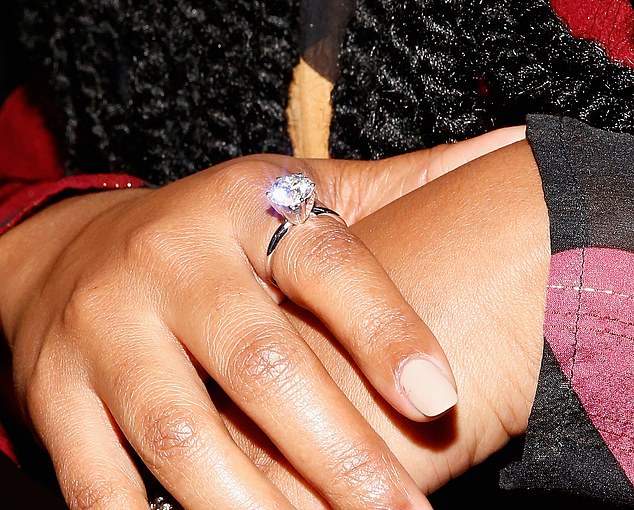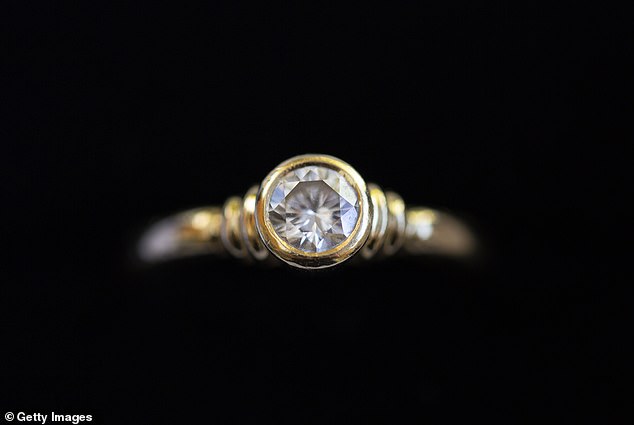When Taylor Swift, Zendaya or Lauren Sanchez step out brandishing an immense new engagement stone, the images ricochet around social media – and suddenly everyone wants one.
This year, average couples are increasingly getting close.
While Art Deco, asymmetrical or mixed metal settings have dominated in the recent past, the celebrity effect has now made a massive diamond the must-have design of 2025.
But what has made them attainable is the wide availability of synthetic diamonds giving people more bling for their buck.
‘Bigger engagement rings are having a moment this year, and lab-grown diamonds are a big reason why,’ Nisarg Mehta, the diamond director of Robbins Brothers Fine Jewelers, told the Daily Mail.
‘It’s all about getting more sparkle for the same budget or less.’
Mehta said that man-made diamonds now account for a whopping 50 percent of engagement rings sold in the US – a dramatic rise from less than 10 percent in 2019
‘The pricing gap explains a lot,’ Mehta explained. ‘A one carat lab-grown diamond now averages around $1,000, whereas it’s around $4,200 for a natural diamond of the same size and clarity.’

Lab-grown diamonds (pictured) now make up 50 percent of engagement rings sold in the U.S. In 2019, they only made up 10 percent
That difference means that many couples can choose larger, higher-quality stones without stretching their budget.
Some also opt for a synthetic diamond for ethical reasons, citing concern over the environmental and human-rights issues surrounding diamond mining.
To illustrate the divide, Mehta compared what some celebrity rings would cost if they were made with lab-grown stones.
Swift’s old-mine brilliant cut diamond – which he believes to be around 10 carats – would cost about $750,000 as a natural stone. A synthetic version, he said, would be about $20,000.
The elongated cushion-cut ring on Zendaya’s finger, estimated at six carats, would cost approximately $275,000 as a mined diamond but about $12,000 man made.
Sanchez’s huge 30-carat pink cushion-cut diamond, set in platinum and studded with smaller stones, is valued at between $1.2 million and $2 million – while an engineered equivalent would be around $50,000.
Her second ring, estimated by several jewelers to be between 30 and 40 carats, would have a $2 million price tag naturally. Mehta thought that a synthetic diamond of comparable size would be around $80,000.
Seeing a five- or ten-carat diamond used to be extremely uncommon, said Monil Kothari, CEO and founder of Haus of Brilliance.

Mehta estimated Taylor Swift’s old mine brilliant cut diamond ring to cost $750,000. He said the same ring as a lab-grown diamond would cost approximately $20,000

Zendaya’s elongated cushion ring has an estimated cost of $275,000. The synthetic version would cost $12,000
Natural diamonds of that size are rare and extremely expensive. But lab-grown stones, he said, have allowed buyers to secure a dramatic, luxurious-looking rock for far less – fueling a surge in eye-popping engagement rings.
‘You can get a visually identical five-carat stone for less than the price of a one-carat natural,’ he said.
Kothari observed that shoppers right now care more about the look and the emotional meaning of the ring, rather than the rarity or resale value.
‘Lab-grown lets them get the scale and presence they want without taking on a luxury-level price.
‘This is why you’re seeing more oversized rings on social media and in everyday life. It’s simply accessible now in a way it never was before,’ he said.
‘We’re also seeing prices continue to fall as production increases so the trend toward larger stones is only going to become more pronounced.’
Alexandria Samit, the founder and CEO of Alexandra Beth Fine Jewelry agreed. She said that clients are requesting bigger and better stones as synthetic diamonds gain popularity and mainstream acceptance.
The average engagement ring they craft with a lab-grown diamond is now four carats – in a country where the typical natural carat weight is around one carat.

Lauren Sanchez’s huge diamond rings, potentially wroth over $4 million combined, would be significantly less if man-made stones were used. The pink stone (L) would cost $50,000, while her second oval ring (R) would cost $80,000

Styles come and go, with subtle diamonds seemingly out of fashion. Instead, jewelers are finding that large stones are in vogue

Lab grown diamonds mean that buyers can buy a luxurious rock for much less, leading to bigger rings than ever
Clint Casmiro, the co-founder of Canadian-based jewelry studio Smiro Studio, has seen an increase of 0.5 carats per year on average.
He noted that three carats is the ‘average size’ for a lab-grown diamond engagement ring and stressed that they are ‘chemically, physically and optically identical’ to their natural counterparts.
‘People can now finally afford their dream ring, and don’t have to make sacrifices any more ,’ Casmiro said. ‘People don’t want to invest in a smaller natural diamond and compromise on their ring because of budget.’
According to Brides magazine, lab-grown stones are produced in conditions that closely replicate those deep underground, resulting in the same chemical and molecular structure.
Not only that but, to the naked eye, a lab-grown diamond is indistinguishable from one formed over billions of years beneath the Earth’s surface.
The overall effect is that Hollywood-sized stones are migrating to the mainstream as a generation of couples shop like A-listers.

